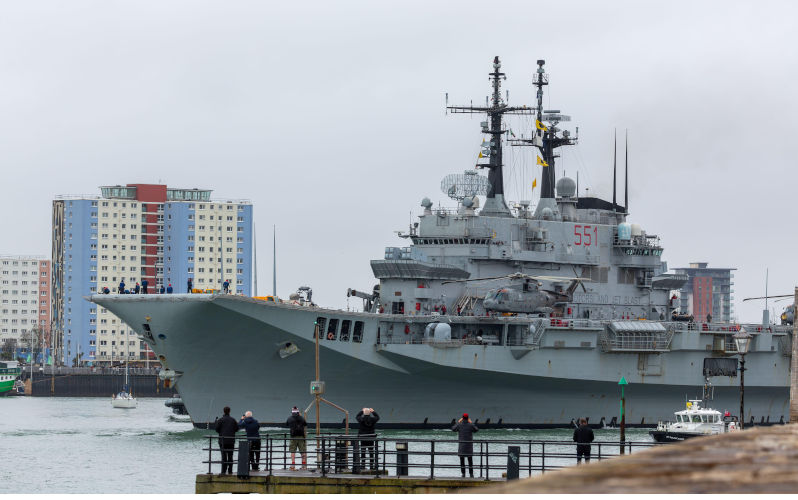Vanity, defence or just wanting to show off?
October 16, 2025
For a demagogue, what could be more stirring than to take the salute on a raised dais as thousands of armed men and women march past like robots in perfect synchronisation?
But if the real goal is to project power and make neighbours quiver, then the autocrat should stand on the flight deck of a mighty aircraft carrier and rule the waves. That’ll sow envy and boost the ego.
Why else is Indonesia’s President Prabowo Subianto negotiating to buy the Italian Navy’s second-hand Giuseppe Garibaldi? It was decommissioned in 2024 after four decades at sea and some “active service” off Libya and Afghanistan.
The president likes parades, usually standing in an open-roof four-wheel drive. But at the pointy end of a mighty ship is even better.
The news that Indonesia was hull-kicking came as a surprise. Commentators were asking the obvious question – why?
Apart from the US, most nations reckon carriers are yesteryear’s military hardware. The UK has only two – it lost five during World War II. Then and now, Germany had no money-gobblers that need protection from flotillas of zippier escorts when they venture into deep water. Even with sophisticated defence weaponry, they’re vulnerable.
This is the age of the armoured drone, ultra-fast missiles and precision-targeted rockets fired by screen jockeys in safe nations far away
China has three non-nuclear carriers. The US has 11, all nuclear powered. The biggest is the 337-metre-long Gerald R Ford, which can carry 80 aircraft and a crew of more than 2000.
It was launched (the military likes to say “christened” as though its mission is love) in 2013, and will be joined by others – at A$20 billion a pop. The French have one, the UK two.
Technically, the Garibaldi — named after the 19th-century Italian general and republican — is an aircraft-carrying cruiser. When renamed, it will probably be the Soeharto after the Republic’s second president and Prabowo’s former father-in-law.
It certainly won’t be christened in Islam-majority Indonesia, but is likely to be blessed with the Koran.
It was designed for short take-off and vertical landing aircraft, like helicopters and Harrier jets. It doesn’t have catapults to fling out heavily armed fighter planes, so it wouldn’t frighten imagined enemies when sailing into their sea-space.
If the A$690 million deal goes ahead, Indonesia will be the only nation in Southeast Asia with a carrier. That should swell national pride, but little else apart from the debts.
We don’t have one in our fleet, having decided that underwater is the way to go. Or we’ve been persuaded that’s the future, though unmanned sub-surface drones may make the bigger boats useless.
Sub crews are difficult to recruit; the job is unpopular with mariners who like to feel real sea breezes. Staring at screens, pulling levers and not seeing if anything has been hit doesn’t launch Top Gun thrills.
The cost of equipping the 150-metre-long Garibaldi steel whale will add A$1.3 billion for choppers to rise off the deck. In 2011, during extended NATO exercises, it reportedly cost the Italian government A$140 million to operate.
That sort of money would help fix Indonesia’s school kids’ free-meal program, which is sickening thousands through bad hygiene and crooked tucker. The programme in 2026 is said to cost A$25 billion.
Indonesia’s military budget this year is around two billion less.
Indonesian Admiral Muhammad Ali, who commands a fleet of 180 boats of all types, wasn't enthusiastic about buying a European ship past its use-by-date and didn’t seem to have been consulted: “It seems we need an aircraft carrier for military operations other than war, especially.”
This was supposed to be a reference to roles other than killing, like helping in natural disaster relief through landslides, earthquakes and floods, which are commonplace in Indonesia.
Choppers are widely used to rescue the victims, but speed is essential if lives are to be saved. In an emergency, getting a carrier to ferry helicopters from one side of the archipelago to the other — more than 5000 km — needs a rapid response, and an old boat isn’t the right delivery vehicle.
Even the right-wing Australian Strategic Policy Institute, supported by the defence industries and usually keen to promote armed solutions to problems, commented:
“The acquisition of a highly sophisticated asset such as an aircraft carrier must be driven by a strategy of co-operation first, and military posturing second. Without a clear need for the ship, Jakarta would risk ending up with an aircraft carrier serving as a static tourist attraction.”
Writers in Melbourne University’s Asialink magazine claimed:
“Allocating more funds for non-strategic military procurement appears to be ill-advised, given the government’s urgent need for crisis management efforts. If the government maintains its decision, this procurement may be seen as an unempathetic and insensitive policy towards what the public needs the most.”
Will Prabowo harken to this Aussie advice? He abhors interference from “foreign powers” so it’s unlikely he’ll pay attention, though the economic arguments may succeed.
In 2013, the government was set to buy another European discard, Spain’s Principe de Asturias. The deal didn’t go through for reasons unknown and the carrier was sold for scrap. Maybe history will repeat.
The views expressed in this article may or may not reflect those of Pearls and Irritations.

